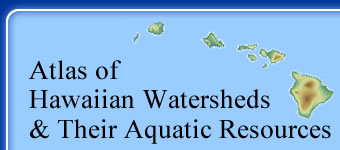
Foreword
Enactment of the State Water Code in 1987 led to the Hawai'i Stream
Assessment (HSA), the first comprehensive effort to compile existing information
about Hawaiian stream biota, published in 1990. The HSA was intended to serve as an
accessible source of information that would evaluate relative stream quality and serve
to rationalize management actions by the State Water Commission. Of particular
importance were their decisions affecting water flows including proposed water
withdrawals, damming, channelization, or other actions that could modify existing
instream habitat.
Not only was basic biological knowledge about stream biota very limited in
1990, but the HSA revealed major gaps in available data about the distribution and
abundance of organisms, both native and introduced, that occupied Hawaiian streams. Given the mandates of the State Water Code, the authority assigned to the State
Water Commission, and its own statutory requirements for the protection and
management of aquatic biota, the Hawai'i Division of Aquatic Resources launched a
program to increase that knowledge base, strengthen the foundation for decision
making, and ultimately provide the means for assuring the future survival of our
unique native biota.
These atlases are a key product of that effort. They represent massive data sets
quickly available to decision-makers, research scientists, and others seeking
information about Hawaiian streams. Properly used, they can help those charged with
Public Trust responsibilities of balancing human demands for water and protecting
Hawai'i’s natural heritage, with special reference to the fact that Hawai'i’s State
Constitution requires that the native organisms occupying these streams must be
sustained for the enjoyment and use of future human populations.
Estuarine findings, absent from the HSA, have been incorporated in the atlases
and will in the future be expanded. Estuaries are the bridge between streams and the
sea, in some ways serving as regulators for the abundance and diversity of organisms
occupying stream habitats, and should be viewed as integral with streams. Separating
an estuary from a stream would be like amputating a limb from one’s body.
The atlases must not be deemed to be ends in and of themselves. They are
meant to be living documents, subject to updates and change as more information
accrues, given the reality that our understanding of stream/estuarine systems is far
from complete. We expect that there will be a continuing commitment to this
program, with benefits that will be magnified as our knowledge base grows.
William S. Devick, Administrator (Retired)
Division of Aquatic Resources, Department of Land and Natural Resources,
State of Hawai'i
February 3, 2008